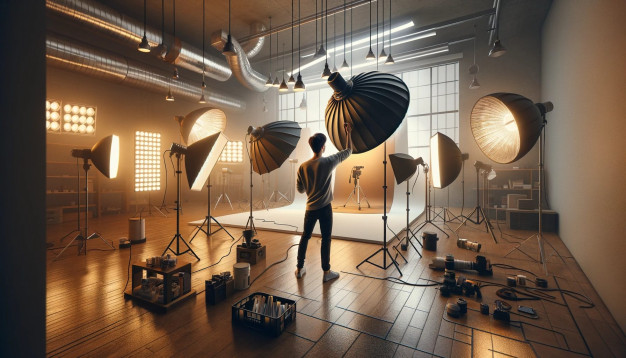Beginner’s Photo Lighting
Master the basics of photo lighting to elevate your shots from good to great.

Importance of Lighting in Photography
Photography is all about capturing light. Lighting determines the mood, texture, and narrative of your images, turning a mundane shot into a masterpiece. Mastering lighting can elevate your photographic game from snapshots to gallery-worthy art.
Understanding Natural vs. Artificial Light
Natural light is the sun’s gift to photographers; it’s free, abundant, and offers a variety of tones from the golden hour’s warm glow to the cool blue of twilight. Artificial light, on the other hand, puts you in the driver’s seat. You get to control intensity, direction, and color, but it can be a wallet’s nemesis if not careful.
Light Direction and Quality
The direction from which light hits your subject can transform their appearance. Side lighting accentuates texture, while front lighting can flatten features. As for quality, soft light forgives while harsh light reveals — it’s like choosing between a hug and a handshake.
Lighting Equipment for Beginners
Types of Lights
You’ve got continuous lights that are like the sun (minus the UV damage) – they’re always on. Then there are flash/strobes – the paparazzi’s best friends. They burst with light faster than you can say “cheese”.
Modifiers and Reflectors
Modifiers are the makeup artists of lighting. They soften, focus, or spread light. Softboxes are like sending your light to finishing school, ensuring it’s soft and polite. Reflectors bounce light like a boomerang, filling in those unflattering shadows.
Essential Lighting Accessories
Stands are the unsung heroes, holding lights like Atlas with the world. A remote trigger is essential unless you’ve mastered telekinesis, and gels are how you paint with light, adding a splash of color to your luminous canvas.
Setting Up Your First Lighting Scheme
The Key Light
Your key light is the star quarterback of your lighting team. It leads the play, setting the scene’s tone and direction.
Fill Light and Its Role
The fill light is the key light’s best friend, always there to support and fill in the shadows, making sure the key light doesn’t get all the glory.
Backlight for Depth and Separation
The backlight is like adding a pinch of salt to your dish – it brings out the flavors. In photography, it separates your subject from the background, giving that three-dimensional pop.
Camera Settings for Optimal Lighting
ISO, Shutter Speed, and Aperture
ISO is your camera’s caffeine sensitivity – higher ISO, more sensitivity. Shutter speed is how long your camera blinks to capture the scene. Aperture is like your eyes’ pupils, controlling the light’s invite to the sensor party.
White Balance and Color Temperature
Getting the white balance right is like matching socks – do it wrong, and it’s all anyone will notice. It ensures the colors in your photos are true to life.
Common Lighting Patterns and Techniques
Loop Lighting
Loop lighting is like the Mona Lisa’s smile – subtle but intriguing. It casts a small shadow of the subject’s nose onto their cheek, perfect for portraits.
Rembrandt Lighting
With Rembrandt lighting, you become a painter. It’s dramatic with a capital D, creating a chiaroscuro effect that whispers tales of the Dutch Golden Age.
Butterfly Lighting
Butterfly lighting flutters around, casting a shadow under the nose. It’s great for those high-fashion cheekbones and an aura of glamour.
Troubleshooting Common Lighting Issues
Dealing with Harsh Shadows
Harsh shadows can be the bullies of photography. Soften them up with diffusers or reflectors. It’s like diplomacy for light.
Managing Overexposure and Hotspots
Overexposure is like a sunburn – too much of a good thing. Tame it down with a lower ISO, faster shutter speed, or smaller aperture. For hotspots, throw some shade with a diffuser.
Practice Exercises and Projects
Indoor Portrait Lighting Setup
Experiment with a three-point lighting setup; play with angles and intensities to see how your subject’s story changes.
Outdoor Lighting Challenges
Take your camera for a date at different times of the day. Learn how the sun’s position changes the scene’s dynamics and how you can use it to your advantage.
Experimenting with Creative Effects
Have fun with gels, play shadow puppetry with objects, or create silhouettes. Flex your creative muscles, and don’t be afraid to try something outrageously different.